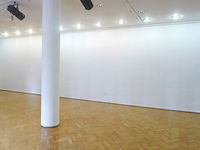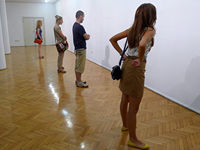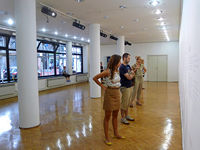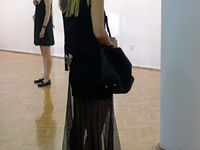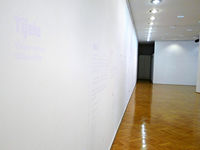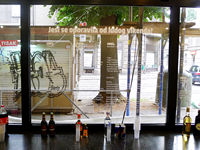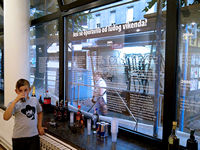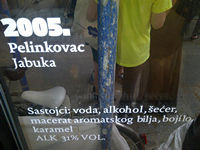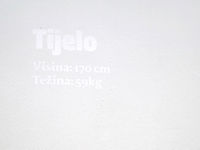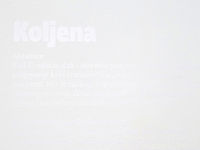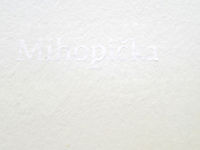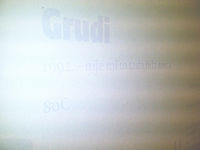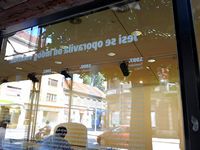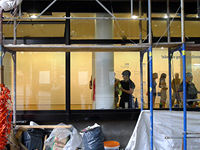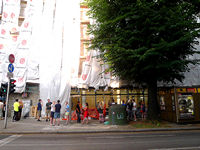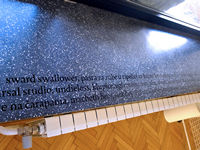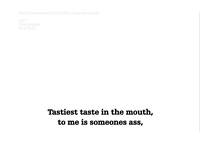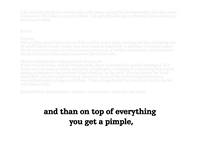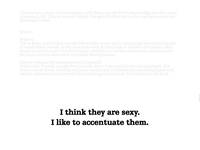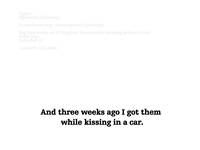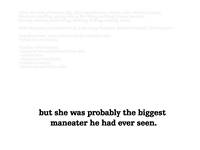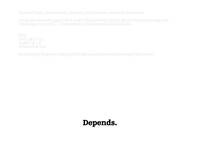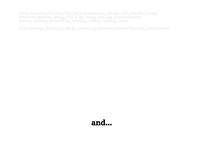Probing
VN Gallery
Zagreb, Cro, 2012
Public sound installation, vinil on walls
The work 'Probing' was based on the interview author conducted within the circle of her friends. Set of the questions were addressing gender, sexual, physical, and sexual identity problems and potential related traumas. The same set of questions author addressed to herself.
Stills from the supportive video:
With the new work Martina continues her exploration into language, which she
problematized earlier in her video installation, Am I? (I am, Something Drives Me
) through a formal conjunction of disassociated images, texts and statements in
first person that were mobilized to perform a brief , absurd and humorous set
of constructed identities. With the new work Martina partly departs from the previous
ones by eliminating the visual elements in order to utilize the sound as a focal
point for her analysis into the relationship between language and the role it
plays in constructing one’s image of private and public self. She begins with the
personal, asking her participants to reveal her an anecdotal story which she
then re- enacts through her own voice, recreating these stories for the gallery
space where they are continuously streamed and thus recasting them as social
actions.
By eroding the boundaries between the speaker and the listener and
assuming both roles, she destabilizes the dominating authority of a speaking
voice in the work, creating situations that allow for questioning of the processes
of identification and asking how do they shift between the artist, her subjects
and the viewer?
Nina Vukelic Thorstensen
What can be fascinating in today's mediated world? To some people it is how a people can change their appearance. To thing this way strikes me as me as unorthodox approach, as it means to be fascinated with the whole history and long process of appearance formations during the history; prolonging necks with the rings, deforming feet in Japan. Today – it can be deforming your feet and spine with high-heels and heavy bags, putting tattoos, dying your hair, plucking eyebrows, trimming hair. Maybe even typing this text contributes to the future deformation of my wrist. Whatever appearance/image of the body is created, (sometimes insistently devoid of such conscious intention to create one), it always operates in the field of looking, seeing, producing images and reception of that image. During dOCUMENTA 13 movie programme included a film about the Exotic World, the museum located on the site of an abandoned goat farm in California. As Raimundas Malasauskas noted during the talk after this film, there is even a verb one can burlesque something. But what does it mean to burlesque something? It means to exercise the gaze of the audience on oneself and lead it, manipulate it, surprise, scare, producing thrill, laughter and pleasure.
Coming to Martina Miholic’s work, she is not that concerned with neo-burlesque as pleasure production or camp, as resistance. Her works are trying to become platforms of self-reflections, in which the participants are invited to speak on their sexual and body identities. In her work, Marina asks the participants questions about their body experiences, guaranteeing anonymity. The answers are used as a content for Martina’s artworks. There she is using the texts as if they would be her own text, her own experience and option. Through her work she tells the story of the people who agreed to answer and share the information with her. Translating these answers through her own presence and artworks, Martina acts as embodying those answers, so that they are not just cold intimacies in the Internet comment fields or forums. Through her work she affirming, and, thus, empowering the participants through the explicit and sometimes uncomfortably mundane content to be the subject of her artwork. Here, the burlesque is not an active agent. However, there is something empowering in the way how the content is of the answers is revealed. It is as if Martina’s work is precisely this embodiment, the trying out on other people’s identities on.
While she reperforms or deconstructs or in other way transmits the answers, the participants of the work are in the distant, no longer in the position of the implicit viewers. This allows the work to act as a double bind. Firstly, it stands as an exercise of psychotherapy, where the subjects that generated content of the work can observe themselves through the eyes of the other person, that is, the artist, and, them, being the other person, in different time and space, observing isolated statements and what these statements are doing.
Juste Kostikovaite
Martina Miholich
the Question Sleeps in her Bed
Lingering upon words and their beneath-the-surface meanings introduce the relationship of guest
and host in Martina Miholich’s 2012 new works. The installation playing on elements of dislocation
and differentiation between listening, hearing and catching detail by dropping an ear in the words
of an artist whose attempt to trigger the exercise of responding as vulnerability in itself. The sound
elements installed within and beyond the interior of the gallery space place its audience at work,
performing a sense of simultaneity in physical and theoretical accumulation of identity standpoints.
The kinetically hosting in Miholich’s work is the quality of the question. Its form of confrontation
achieves nearness in proximity to the viewer’s information but always maintains a time lapse
between the question and the truth within the answer. In a fictional setting where the viewer is guest
to the hosting questions, traumatic moments are being targeted in an attempt to relate to ideas of
individuality, identification, readability within information, fragmentation of context, and audience
networking.
Miholich’s exhibitions deprive the work from being enclosed in a single volume of space. The
possibility of information being transmitted, translated and lost allow for the work to achieve a
communicable sculptural quality in the space introducing audience-answering as new functionality.
A complexity the artist treats as an entrance into the realm of tactical questioning. An inivisible
threshold allowing for the character of the witness to play, the element of constructed memory to
become fictional, and an alteration of anxious viewers into secure observers. When questioned,
archives of knowledge are placed at work highlighting the viewers’ capability of allocating memory
and reiterating its fictional containment into present reality which add a layer of story-telling in
Martina Miholich’s work. One where the thread of responses might be only ever-completed within
this never-ending extension of narrative. The personal quality of the questions becomes dominated
by ideas of familiarity, insecurity and censorship, providing a platform for political underpinnings of
the exhibition’s context to be articulated.
Areej Kaoud
